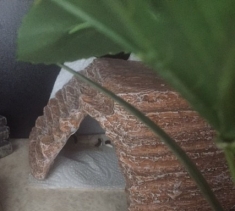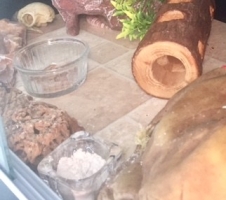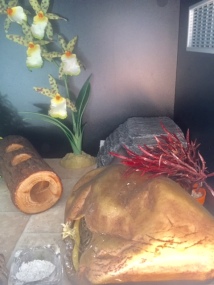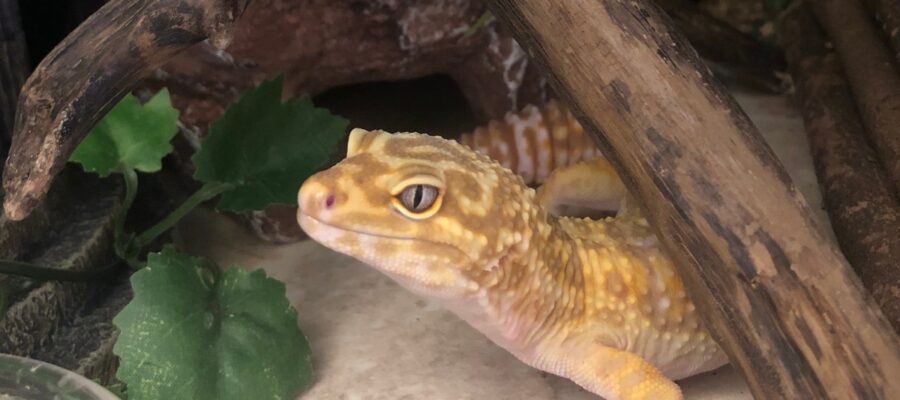The cleaning frequency of any pet varies from owner to owner, so in this post I’m going to give an overview of my personal cleaning process for my leopard geckos.
If you home multiple reptiles together (which is not recommended), or if your leopard geckos eat a lot, then they will most likely need cleaning more frequently than an older, solitary leopard gecko who eats less and defecates infrequently.
I have two vivariums, each homing one leopard gecko. One gecko eats a lot more than the other, therefore requiring slightly higher maintenance than the other one.
Daily spot cleans
 I spot clean the vivariums almost on a daily basis. When I say spot clean, I mean clearing away any poop when it appears, so that it doesn’t start to smell. This may sound like a hassle but I have a very quick method to do this…
I spot clean the vivariums almost on a daily basis. When I say spot clean, I mean clearing away any poop when it appears, so that it doesn’t start to smell. This may sound like a hassle but I have a very quick method to do this…
I place kitchen towel under the hide, in the corner they use for their pooping, and when it’s time to clean, I simply remove the paper and throw it away.
More detail here: The lazy way to spot-clean your leopard gecko’s vivarium
Weekly substrate/ dish cleans
 My leopard geckos are kept on vinyl, which is super easy to wipe clean (see: Vinyl substrate for leopard geckos: Review). It’s important to use a special reptile disinfectant because harsh chemicals can be harmful to leopard geckos, so I use Pro Rep Viv Clean sprayed onto the vinyl and then wipe it with some kitchen towel.
My leopard geckos are kept on vinyl, which is super easy to wipe clean (see: Vinyl substrate for leopard geckos: Review). It’s important to use a special reptile disinfectant because harsh chemicals can be harmful to leopard geckos, so I use Pro Rep Viv Clean sprayed onto the vinyl and then wipe it with some kitchen towel.
I find that their flooring gets covered with bits of insect, moss, bark from their hides/ decor, but even if there is no visible mess on the floor it’s still a good idea to wipe it down and remove any bacteria.
We are now selling vinyl substrate: click here to purchase some
I also like to clean their feeding and water dishes at least every week, because bacteria can easily collect here. For their food dishes, I use glass ramekins as they are smooth-sided (most insects I use can’t escape from here), it’s easy to spot dirt in them, and can be put in the dishwasher.
Monthly deep clean
 About once per month, I will take the geckos out of their vivarium (and put them in a safe container with hides) and remove all hides, decorations, the vinyl substrate and feeding dishes and give them a big wash in the sink with the reptile disinfectant and running water.
About once per month, I will take the geckos out of their vivarium (and put them in a safe container with hides) and remove all hides, decorations, the vinyl substrate and feeding dishes and give them a big wash in the sink with the reptile disinfectant and running water.
I also clean the bottom of the vivarium, getting all dirt, dead insects etc from the corners of the vivarium.
I try to get everything as dry as possible otherwise the humidity levels and condensation are too high once it’s all back in its place.
This process takes about an hour for both vivariums, and slightly less time if I have a second pair of hands.
As mentioned, the cleaning frequency needs to be adapted to your individual geckos; some will need doing more than this and some may need to be cleaned less, so use your best judgement. Good luck!
Get Your Free Leopard Gecko Care Checklist!
Are you ready to give your leopard gecko the best care possible? Download our FREE PDF e-book featuring a comprehensive care checklist!
This handy guide covers everything from habitat setup to feeding and health tips, ensuring your gecko thrives.
👉 Download your checklist now!




